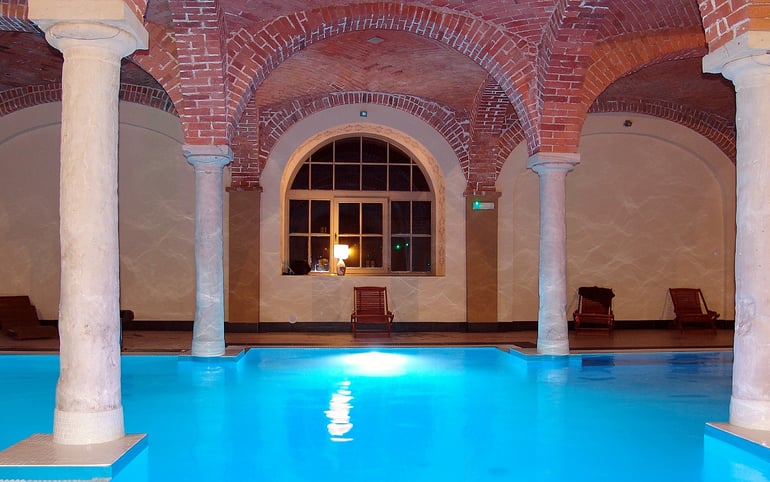
Due to their complex design and often considerable size, hospital water systems can harbour a multitude of pathogens and microorganisms. Amongst the most common in healthcare water systems are gram-negative bacteria such as legionella, with other lesser known organisms such as mycobacteria. Fungi and mould may also be present, if less abundant.
Hotel management need to be aware of the circumstances that can lead to an increased risk of these bacteria colonising their water systems and take appropriate precautions to protect both hotel workers and their guests.
Unlike some other hazards to health & safety, such as a broken paving slab, obstructed fire exit, or broken window restrictor, the hazards contained within a water system may be hidden from view in roof voids, ducts or cupboards or even too small to see with the naked eye.
Some common issues with hotel water systems are discussed below, it’s not an exhaustive list but it highlights some of the most common hazards and possible solutions.
Legionella pneumophila
This micro-organism may well be the most well-known pathogen present in building water systems due to media attention and management practices which have been integrated into workplace health and safety over many years. Significant Legionella contamination of a water system can result in people contracting Legionnaires’ disease – a form of atypical acute pneumonia. Legionnaires’ disease results in fever, muscle pain, nausea and can cause death in the worst cases. Risks are dependent upon a combination of factors including:
- the bacteria being present in sufficient numbers;
- suitable conditions ie temperatures between 20°C and 45°C;
- a source of nutrients ie scale, corrosion etc;
- a means of disseminating aerosols;
- the presence of people with compromised immune or respiratory systems or other health factors e.g. smoking, that increase their susceptibility to Legionella infection.
Comprehensive guidance is provided in the Health & Safety Executive’s publications Approved Code of Practice [ACOP] L8 and the associated HSG274 Technical Guidance. Control schemes should be designed to:
- avoid conditions that support growth of microorganisms, including legionella;
- ensure water cannot stagnate anywhere in the system - regular use / Legionella flushing regime, keep pipework as short as possible, remove redundant pipework and dead-legs;
- use approved materials and avoid any that encourage bacteria and other microorganisms;
- keep the system and the water in it clean;
- treat the water to either control or limit the growth of microorganisms;
- monitor any control measures applied;
- keep water safety records of all actions taken.
Cross-Connections
Drinking water supplies in the United Kingdom are protected by law and the Water Supply (Water Fittings) Regulations set out the requirements for plumbing installations downstream of the water undertaker’s communication pipe and stop valve. The Regulations are concerned with preventing the waste, misuse, undue consumption, erroneous measurement and, most importantly, contamination of the drinking water supply.
Contamination passing back upstream from downstream in a water distribution system is known as backflow.
Under the regulations it is forbidden to directly connect the mains cold water supply to a fluid of a lower quality without the required level of backflow prevention.
The source of backflow contamination could be any fluid that is not drinking water fed directly from the mains supply. This includes common building water systems such as tank-fed water supplies, hot water systems, softened water, central heating water, garden irrigation systems, gutters, drains or even waste-water systems.
There have been widely reported incidents of backflow contamination due to incorrect plumbing practices, such as the school in which a cross-connection to the heating system caused contamination of the children’s drinking water fountain.
To avoid cross-connection problems always use an approved plumber.
‘Dead’ or ‘Blind’ Ends
Often found where redundant services have been disconnected from the water system, these “capped” or “cut-off” pipe ends can contain stagnant water and act as a breeding ground for waterborne micro-organisms.
The more dead-ends that are present within a water system the higher the risk to users. Older systems that have been modified many times are most likely to contain them but even new systems are sometimes left with dead-end supplies for future connections, this is not recommended!
It has been proven that even small dead-ends can contain sufficiently robust colonies of bacteria to recolonise entire water systems even after disinfection. As such, there is no recommended maximum length for dead-ends. Regardless of pipe diameter, the preferred approach is to remove the whole length of the dead-end pipework along with any associated branch joint and replace with straight pipework.
In rare cases it may be impractical to remove the whole dead-end, in each case the risk should be assessed to enable a decision to be made as to whether a dead-end should be left or whether the pipe should be fitted with an outlet to allow it to be flushed weekly.
Over-Sized and Poorly Fitted Storage Cisterns
Cisterns that are too large in comparison to the demand for water downstream will not experience the required throughput of fresh water to maintain hygienic conditions. Such cisterns will suffer from stagnation and this may lead to the conditions in which the number of waterborne bacteria can quickly grow out of control.
All cold water storage cisterns and associated fittings should be compliant with the Water Supply (Water Fittings) Regulations. Storage cisterns storage capacity should be minimised and should not normally exceed that required for one day’s water use i.e. the entire contents is used and replenished with fresh water at least once in every 24-hour period.
Cisterns should also be fitted with:
- a secure & tightly fitting lid that excludes light, debris, insect & vermin;
- a screened air vent;
- insulation to prevent freezing and excessive heat gain;
- servicing valves on the inlet and all outlets;
- a screen on the warning pipe and overflow pipe (if fitted).
Any hot water vents terminating over the cistern should be redirected to a safe and conspicuous location via a tundish with Type AA air gap. Any redundant opening in the cistern lid should be sealed with approved materials.
Dead-legs
A dead-leg is any part of the system which does not regularly experience a flow of water.
Dead-legs may occur where particular equipment or plant is installed, such as emergency showers or closed system filling systems. The length & operational impact of these ‘necessary’ dead-legs should be minimised by good design practices.
Other dead-legs may be caused by infrequent or intermittent use of outlets such as unoccupied rooms or rooms and other services that are otherwise not in use e.g. services subject to seasonal-use.
Like over-sized storage cisterns, dead-legs allow stagnation to occur increasing the likelihood of conditions that give rise to the increased activity of micro-organisms.
Flushing of infrequently-used outlets, rotation of rooms in use, pipework alterations, automatic flushing devices, draining and disconnecting redundant or seasonal services are all strategies that may be used to reduce the risk from dead-legs in hotel water systems.
Fear not, help is at hand!
To avoid problems with new, refurbished or repaired water systems hotel managers’ should ensure that all plumbing work is carried out by an ‘approved contractor’ who is registered to either Watersafe or one of the seven affiliated approved plumber schemes.
To identify problems with an existing system a site survey and inspection undertaken by a Water Hygiene Centre risk assessor, as an intrinsic part of a Legionella Risk Assessment, can help identify many if not all of these common problems and other hazards within a hotel’s water systems.
To learn more, read our article
Legionella in hotels - everything you need to know
Feel free to reach out if you have any questions about the issues mentioned above or if you would like to consult with one of our experts on water hygiene.
Editors Note: The information provided in this blog is correct at date of original publication - June 2019.
Image by travelspot from Pixabay
© Water Hygiene Centre 2019








